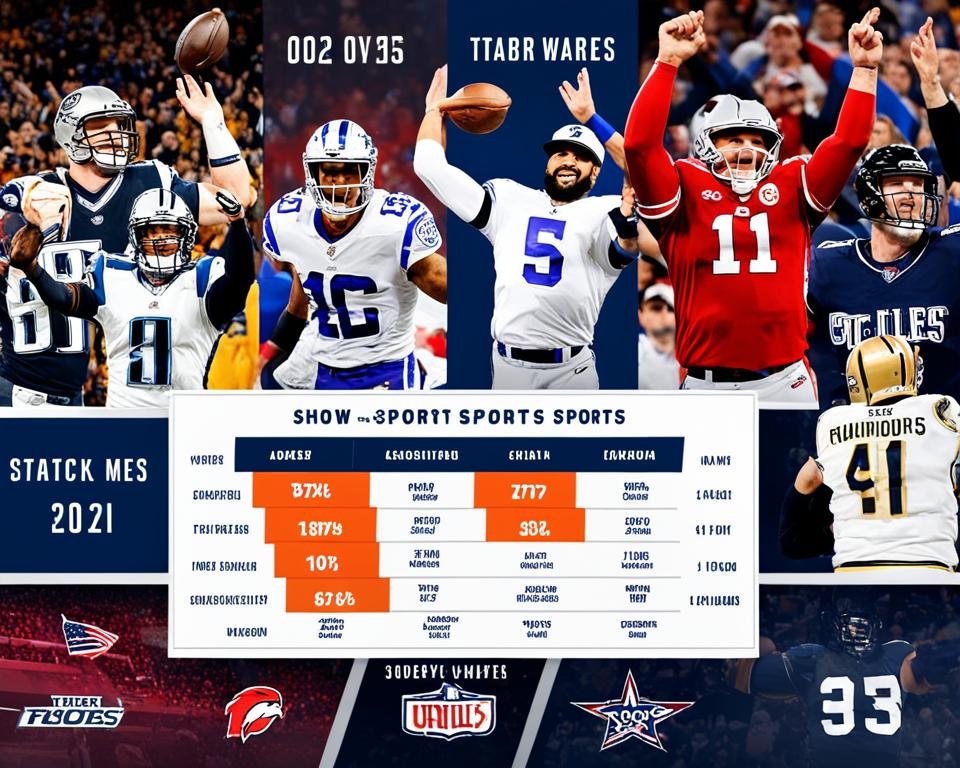Analyzing the viewing habits of sports enthusiasts offers a compelling glimpse into the evolving landscape of the sports industry. As dedicated fans around the globe tune in to their favorite events, understanding the sports fans behavior, viewing habits analysis, and the pervasive sports industry trends becomes essential for stakeholders aiming to capitalize on the dynamic market.
Recent advancements in technology have ushered in a new era for how sports content is consumed. Now, more than ever, access to an ever-expanding array of platforms allows fans to engage with live and recorded events on their terms, leading to significant shifts in viewership statistics. This opening analysis sets the foundational groundwork for uncovering the patterns that shape how contemporary audiences interact with sports—a topic that is especially relevant amidst the rapidly increasing options for accessing sports media.
Key reports and studies cast light on these trends, offering essential data to unpack throughout this article. As we delve into the minutiae of the data, we’ll explore how the rise of streaming has reshaped fan engagement, dissect the demographic clusters that define viewership contours across different sports, and evaluate the monumental impact major sporting events exert on global audience numbers.
The Rise of Streaming in Sports Viewership Statistics
The landscape of sports broadcasting has undergone significant transformations with the advent of OTT platforms sports, which have catalyzed digital viewership growth. This evolution marks a shift from traditional viewing on cable to live sports streaming, offering fans flexibility and immediacy like never before.
Live sports streaming is becoming a dominant force in how audiences engage with sports, driven by a surge in OTT platform offerings. As more sports leagues and organizations sign exclusive streaming deals, the shift towards digital platforms is not just an option but a preferred choice for many sports enthusiasts. The role of OTT platforms in sports has not only expanded accessibility but also intensified fan engagement and interaction.
- Subscriber Growth: The number of subscribers to OTT sports services has seen exponential growth, reflecting a broader trend towards digital content consumption.
- Exclusivity Deals: Exclusive streaming rights for major leagues and events have become a strategic asset for OTT platforms, drawing viewers away from traditional TV.
- Viewer Preferences: Fans are increasingly favoring platforms that offer real-time, on-demand access to their favorite sports, irrespective of their geographical location.
The rise of OTT platforms and digital viewership is reshaping how sponsors and advertisers invest in sports broadcasting, pointing to a future where digital platforms could become the primary hub for sports broadcasting. The continuous improvement in streaming technology and personalized viewing experiences are crucial factors propelling the growth of live sports streaming, making sports consumption more tailored and engaging than ever.
Analyzing Demographics: Who Watches What in Sports
The complex landscape of sports viewership is deeply influenced by varying demographics, capturing the essence of diverse interests across age, gender, and geographical lines. A deep dive into these factors not only enlightens us about current trends but also shapes future broadcasting strategies and marketing campaigns tailored to specific audiences.
Age Groups and Sports Preferences
Sports viewership by age reveals significant insights into generational viewing patterns. Millennials sports trends, for instance, show a substantial inclination towards fast-paced sports like basketball and soccer, facilitated by digital platforms that offer highlights and interactive experiences. On the other hand, older generations such as Gen X and Baby Boomers often prefer traditional broadcasts of golf and baseball, indicating a divergence in media consumption habits as well.
- Generation Z: Prefers quick content, e.g., highlights on social media platforms.
- Millennials: Favor interactive and on-the-go viewing experiences of football and basketball.
- Gen X and Baby Boomers: Often stick to traditional viewing methods, enjoying sports like baseball and golf.
Gender Differences in Sports Viewing
The exploration of gender-based viewing habits uncovers notable differences in sports popularity between males and females. Male viewership statistics typically skew towards intense, physical sports such as football and rugby, while female sports viewers often gravitate toward athletics, tennis, and gymnastics, which are regularly covered during international events like the Olympics. These trends are crucial for marketers aiming to reach gender-specific audiences effectively.
- Male Viewers: Predominantly follow football, rugby, and basketball.
- Female Viewers: Show greater interest in tennis, gymnastics, and volleyball.
Geographical Variations in Viewership
Regional sports popularity plays a pivotal role in shaping local sports viewership habits. For instance, cricket dominates in India and Australia, while soccer is unrivaled in Europe and South America. Time zones also affect live sports consumption, with late-night or early-morning international broadcasts attracting fewer viewers in certain regions. This section highlights how deeply local culture and regional identities are intertwined with sports consumption.
- America: Baseball, basketball, and American football see the highest engagement.
- Europe: Soccer is tremendously popular, with significant viewership for tennis and Formula 1.
- Asia: Cricket and badminton dominate, with a growing interest in soccer.
Sports Viewership Statistics: Impact of Major Sporting Events
Major sporting events not only captivate millions worldwide but also significantly reshape sports viewership statistics and fan engagement across the globe. From the Olympics to the FIFA World Cup, each event brings its unique flair and audience, reflecting broader global viewership trends and the cultural significance of sports. Let’s dive into the distinct impacts of these international sports events.
Olympic Games and Global Viewership
The Olympic Games are not just a series of sports competitions; they are a global spectacle that garners immense viewership. Olympics audience statistics illustrate the event’s massive global reach, which brings together disparate nations in a celebration of unity and athletic prowess. Recent trends indicate a shift in how audiences consume the Olympics, with more viewers tuning in from digital platforms to follow their favorite sports or athletes, impacting global viewership trends significantly.
- Detailed broadcasting strategies cater to international time zones, maximizing reach.
- Increase in ancillary content viewership, including athlete stories and behind-the-scenes footage.
The Super Bowl’s Audience Metrics
Super Bowl viewership consistently ranks at the top of American sports ratings, making it a crucial event for NFL fan statistics as well. The unique blend of high-stakes competition, star-studded halftime performances, and innovative commercials keeps American audiences—and increasingly global viewers—glued to their screens. This event’s viewership provides critical insights into trends in American sports ratings, highlighting the NFL’s dominant place in the sports broadcasting hierarchy.
- Analysis of viewer demographics reveals a diverse audience with varying preferences in content consumption.
- Impact of broadcasting rights and viewer access on overall viewership metrics.
World Cup Soccer: A Unifying Force
The FIFA World Cup stands out as one of the prime examples of international sports events that command a vast global sporting events audience. Soccer fan demographics are incredibly diverse, illustrating the sport’s universal appeal. The World Cup’s ability to unify different cultures and nations under the banner of sport is unparalleled. FIFA World Cup viewership not only spikes during the event itself but also encourages engagement in the form of viewership of qualifiers, historical match-ups, and celebratory broadcasts in different countries.
- Challenges for broadcasters dealing with multiple time zones and ensuring live coverage.
- Increased viewership during live matches and significant interactions on social media platforms.
Trends in Fan Engagement and Social Media Influence
In the evolving landscape of sports viewership, sports social media engagement has established itself as a pivotal player. Platforms like Twitter, Instagram, and Facebook have transformed the way fans interact with their favorite sports, teams, and athletes, creating an immersive environment that extends well beyond the game’s time limits. The ubiquity of social media has given rise to second-screen practices, where viewers engage online while simultaneously watching a live event, leading to a more enriched fan experience.
Through real-time updates and the ability to share instant reactions, social media has catalyzed a new form of fan interaction trends. Enthusiasts are not only spectators but active participants, live-tweeting events, celebrating monumental victories, and even commiserating over disappointing losses. This heightened level of interaction has likewise become a significant aspect of digital sports marketing, with leagues and teams leveraging these platforms to release exclusive content, host virtual events, and drive merchandise sales. Indeed, such strategies are testament to the sophisticated symbiosis between digital marketing and sports viewership dynamics.
Statistics further underscore the impact of these trends. A notable uptick in fan engagement can be seen during major sporting events where viral moments are shared across the globe, amplifying the reach of powerful sports narratives. Subsequently, the commercialization of sports through social platforms has burgeoned, facilitating unprecedented levels of personal interaction between athletes and fans, thus shaping a new era of sports culture – one that is distinctly digital, highly interactive, and immensely communal.



